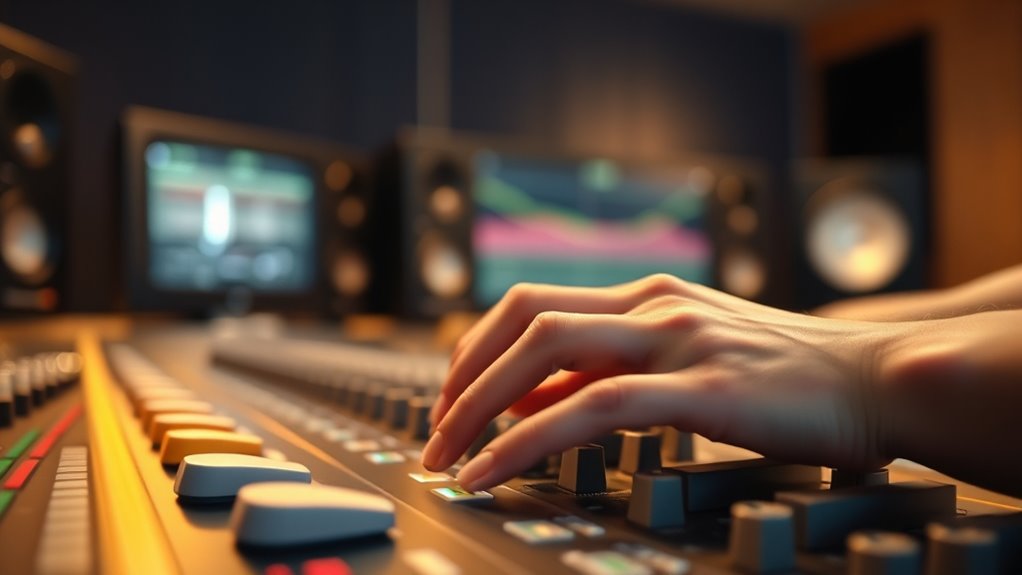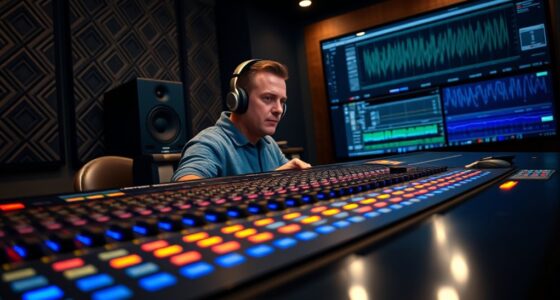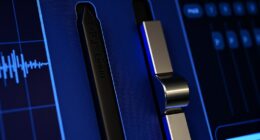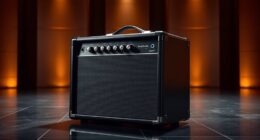To reduce ear fatigue during long mixing sessions, stay mindful of subtle signs like dull aches or muffled sounds and take regular breaks to reset your ears. Set up your space with speakers at ear level and minimize reflective surfaces to create a comfortable listening environment. Manage sound levels carefully, using tools to keep volumes consistent and avoiding sudden spikes. Incorporate focus techniques and proper ergonomics to protect your hearing—continue exploring ways to keep your ears fresh and focused longer.
Key Takeaways
- Practice active, deliberate listening to stay engaged without overloading your ears during long sessions.
- Take regular breaks to reset hearing sensitivity and prevent ear fatigue.
- Maintain consistent sound levels and use volume normalization tools to avoid sudden loudness spikes.
- Create a comfortable, acoustically treated environment to reduce reflections and external noise interference.
- Incorporate mindfulness techniques, such as focused attention and breathing exercises, to enhance concentration and reduce stress.
Recognizing the Signs of Ear Fatigue
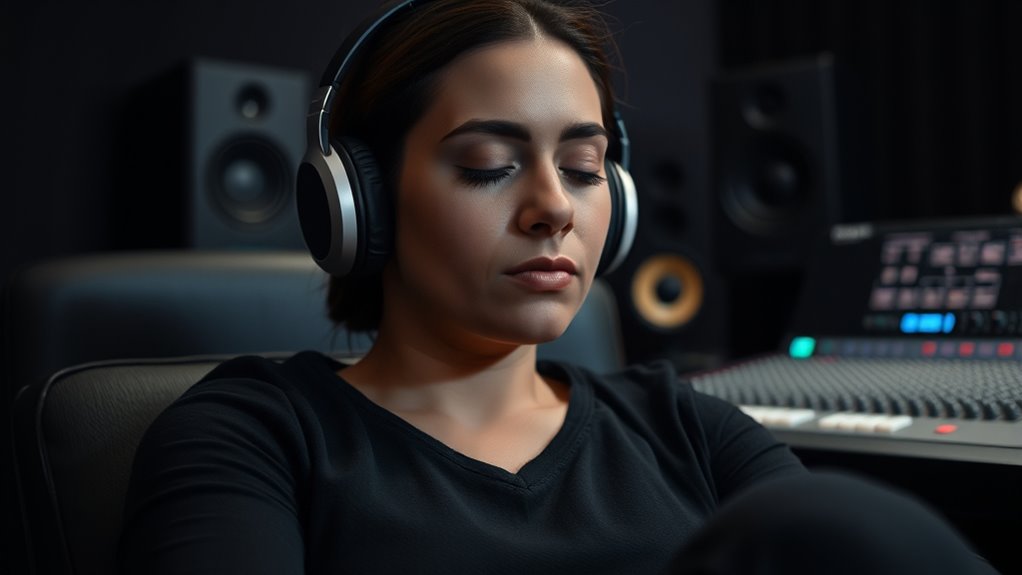
Ear fatigue often creeps in subtly, making it easy to overlook until it becomes uncomfortable. You might notice signs of ear strain, like a dull ache or a feeling of fullness, after hours of listening. Listening fatigue can cause your concentration to wane, and your ears may feel overly sensitive or sore. You could also experience ringing or a sense of muffled hearing, which signals your ears are overworked. These symptoms often develop gradually, so paying attention is key. If you start feeling tired or notice discomfort during your mixing sessions, it’s a clear sign to take a break. Recognizing these early signs helps you prevent further ear strain and preserves your hearing health over time. Being aware of the importance of ear health can motivate you to implement mindful listening habits.
Setting Up Your Listening Environment for Comfort
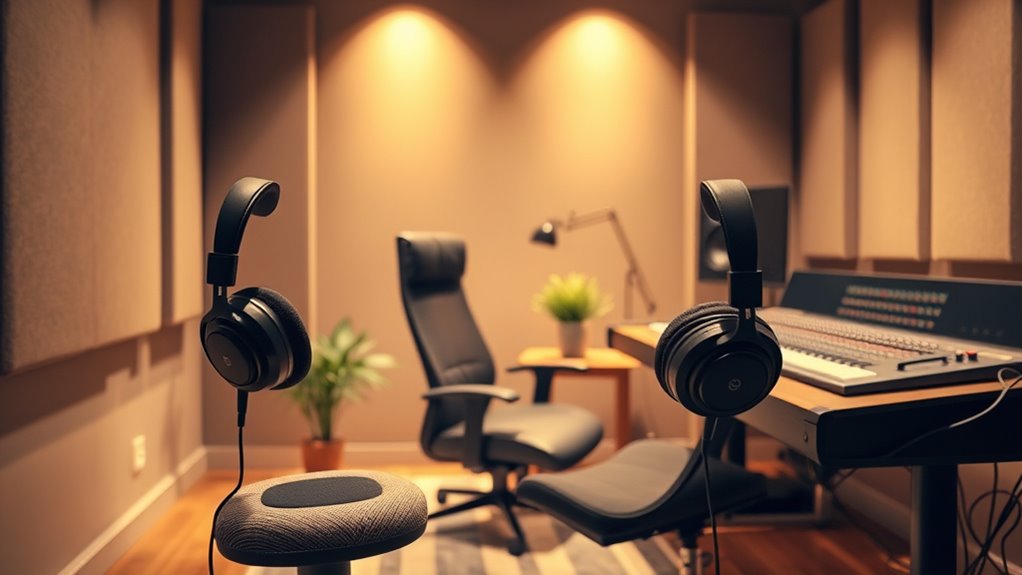
Creating a comfortable listening environment is vital for protecting your ears and maintaining focus during mixing sessions. Proper speaker placement ensures you get an accurate sound image without unnecessary strain. Position your speakers at ear level, forming an equilateral triangle with your listening position. Room acoustics also play an important role; avoid reflective surfaces and consider acoustic treatments like panels or bass traps to reduce echo and noise interference. Additionally, using quality soundproofing materials can further improve your listening environment by minimizing external noise and preventing sound leakage.
Implementing Effective Sound Level Management
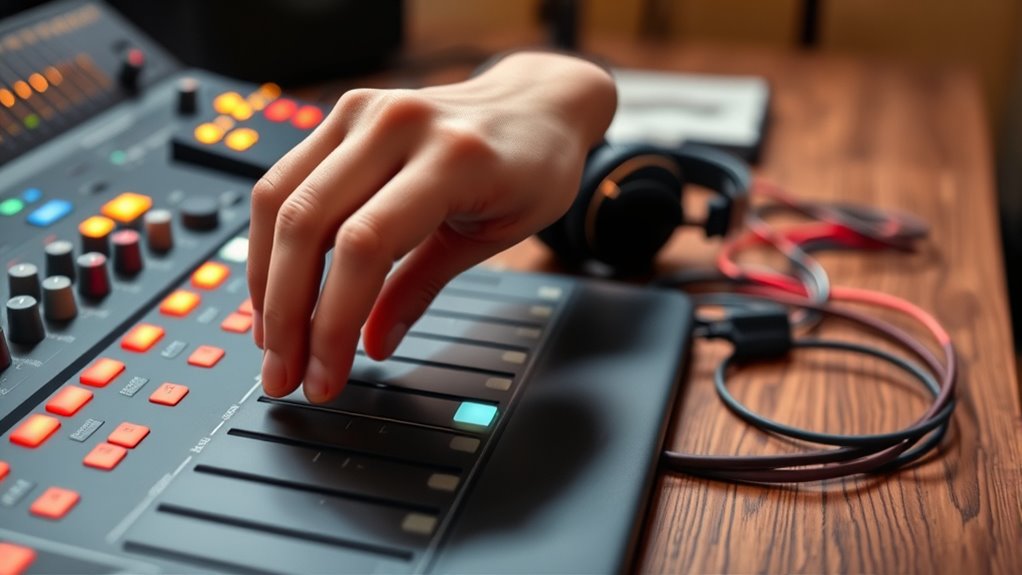
Managing your sound levels effectively is essential to prevent ear fatigue and make sure your mix translates well across different listening environments. Start by using volume normalization tools to keep levels consistent, avoiding sudden loud spikes that strain your ears. Focus on maintaining a balanced dynamic range, where loud and soft sounds are proportionate, reducing the need for constant volume adjustments. This approach helps you listen longer without fatigue and ensures clarity in your mix. Regularly monitor your levels with accurate meters, and adjust accordingly to keep everything within a comfortable listening threshold. Remember, controlling your sound levels isn’t just about loudness; it’s about creating a sustainable workflow that protects your ears during extended sessions. Proper level management enhances both your comfort and your mix quality. Incorporating sound level management techniques that align with best practices can further optimize your listening experience and prevent fatigue.
Incorporating Regular Breaks Into Your Workflow
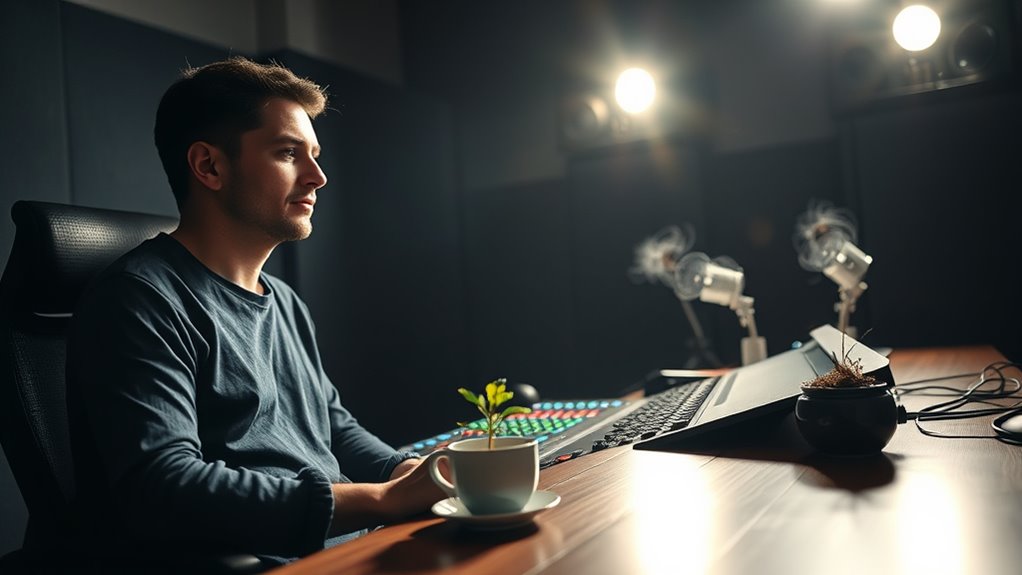
Taking regular breaks during your workflow is essential for maintaining focus and preventing fatigue. Breaks help you reset your mind, reduce ear strain, and improve overall productivity. During these pauses, stay hydration aware by drinking water to keep your ears and body refreshed. Pay attention to workspace ergonomics—adjust your chair, monitor, and keyboard to avoid tension buildup. Consider stepping away from your setup entirely, stretching, or doing quick eye exercises. These small actions can considerably reduce discomfort and ear fatigue over long sessions. Incorporating sound therapy techniques into your routine can further promote relaxation and help mitigate ear fatigue. Remember, your ears need downtime just like your body. Incorporate scheduled breaks into your workflow to stay sharp and mindful. Your ears—and your mix—will thank you for it.
Developing Mindful Listening and Mixing Habits
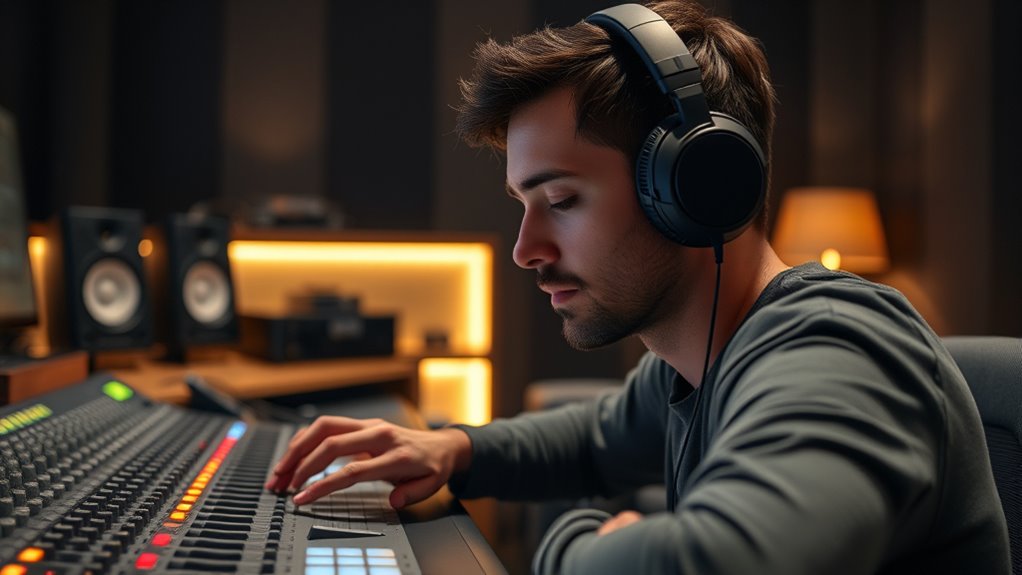
Developing mindful listening and mixing habits requires your full attention and intentional focus. You must actively engage with sound perception, paying close attention to how each element interacts within the mix. By practicing deliberate listening, you improve your ability to notice subtle details and avoid rushing through decisions. Hearing adaptation plays a key role—your ears can become less sensitive to certain sounds over time, so taking regular mindful pauses helps reset your perception. Cultivate habits like pausing to assess your mix objectively and avoiding multitasking while listening. These practices train your mind to stay present and attentive, reducing ear fatigue and sharpening your hearing. Incorporating mindfulness into your routine can further enhance your focus and overall well-being. Over time, mindful habits enhance your mixing accuracy and create a more sustainable workflow.
Frequently Asked Questions
How Does Ear Fatigue Affect Long-Term Hearing Health?
Ear fatigue can seriously impact your long-term hearing health, leading to temporary hearing loss and increasing the risk of permanent damage. When you experience musician fatigue, you might push your ears harder, risking hearing preservation. To protect your hearing, take regular breaks, lower volume levels, and stay mindful of discomfort. These habits help prevent long-term damage, ensuring you enjoy your music and craft without compromising your hearing health.
Are There Specific Headphones That Minimize Ear Fatigue?
You’ll find that headphones designed for comfort and sound isolation help minimize ear fatigue during long sessions. Look for models with cushioned ear pads and adjustable headbands, which reduce pressure on your ears. Over-ear headphones with good sound isolation prevent you from increasing volume to block outside noise, protecting your ears and maintaining comfort. Brands like Sennheiser, Beyerdynamic, and Audio-Technica offer options that prioritize both headphone comfort and effective sound isolation.
Can Diet or Hydration Influence Ear Fatigue During Mixing?
Hydration effects can profoundly influence ear fatigue during mixing, as staying well-hydrated helps maintain inner ear function and reduces discomfort. Dietary influences, like consuming magnesium-rich foods or avoiding excessive caffeine, also support ear health and decrease fatigue. By drinking enough water and eating a balanced diet, you can improve your focus and comfort during long sessions, making it easier to stay attentive without feeling drained or overwhelmed.
What Are Quick Relief Techniques When Experiencing Ear Fatigue?
Did you know that taking short breaks can reduce ear fatigue by up to 50%? When experiencing ear fatigue, try an ear massage to stimulate circulation and relieve tension. Incorporate stretching exercises for your neck and shoulders, which can ease discomfort. These quick relief techniques help you stay comfortable and focused during long sessions, preventing further strain and ensuring you maintain ideal listening clarity.
How Does Ambient Noise Impact Ear Fatigue Levels?
Ambient noise, like background noise, can influence your ear fatigue levels by affecting distraction levels. If the noise is too loud or unpredictable, it forces your ears and brain to work harder to process sounds, increasing fatigue. However, gentle background noise can mask abrupt sounds, reducing strain and helping you stay focused. Striking a balance with ambient noise can make long sessions more comfortable and less tiring for your ears.
Conclusion
Think of your ears as a delicate garden—you wouldn’t let it get overwhelmed with harsh sunlight or drought. By practicing mindful mixing and taking regular breaks, you protect your hearing, ensuring your creative flow stays healthy. Just like a gardener tends to their plants daily, tending to your ears keeps your sessions productive and enjoyable. Remember, a little care goes a long way—so nurture your hearing, and your music will flourish for years to come.

